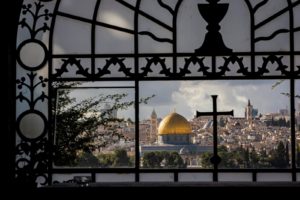Twisted copper sits on the floor, shining under studio lights. Is it a fold of her dress? A section of arm? It’s hard to tell when you can’t see the rest of her, but the remaining pieces are scattered across the world.
The exhibit is titled “We the People,” after the main piece by artist Danh Vo. The work is a recreation of the Statue of Liberty separated into nearly 300 parts. Several of these parts are included in the display at the Israel Museum of Jerusalem.
The exhibit explores national identity through the fragmentation of a common symbol of freedom, the displacement and immigration of persons, the creation of a defining constitution, and the meeting of countless personal identities and cultural systems.
My trip to Israel, co-sponsored by the Philos Project and Museum of the Bible, was like taking a walk through this display. I was immersed in the Israeli struggle with identity. My plan was to learn enough about the country’s complicated faith, history, and political situation so that I could better engage in discussions of the “Israel problem.”
As a lecturer on the trip told us, however, countries are not math problems. To say, “Israel is complicated” might be true, but that implies that there are just more things about Israel that need explaining and, as long as you include all the factors, you can come to the correct solution.
Instead, we should approach Israel like we approach art. In politics, Israel is a problem. In warfare, it is a breeding ground for conflict. In art, however, Israel is a joy to wrestle with.
The task of coming to know art on its own terms is difficult because it requires humility — a humility that is directly related to identity. Not only are we tempted to impose our own beliefs on another’s art, culture, and country, but there is the perhaps greater temptation to say that this humility demands we give up our biases and beliefs. It says that to understand another we must diminish ourselves.
This was not the request we received from the people we met in Israel. We heard of the effect that constant missile alerts have on the children living near Gaza as we stood next to their concrete shelter that doubled as a playground. We heard a Christian man’s stories of Syrian and Iraqi Christians who are dragged out of their homes and brutally murdered as we ate dinner in his home with a four-foot statue of the Virgin Mary standing by the door.
The Israelis that we met gave us their experiences in a spirit of hope and gratitude. What they asked was not that we give up our own beliefs and experiences, but that we would hold them alongside ours. The humility that allows one to do this comes from the belief in a Truth that is much greater than the small piece we claim.
Reading news stories about the Middle East, I often hear the same little “art critic” voice in my head that spoke to me in the Israel Museum: “that twist in the metal means this, those dents must represent that, the color obviously reflects these things…”
Going there didn’t give me an infallible knowledge of Israel’s identity, but it helped me appreciate the people trying to bring the pieces together.

